
by Ray Bodrey | Oct 14, 2021
Tree dieback is a complex syndrome and slow developing. Dieback is essentially a process in which trees lose leaves and limbs. This usually occurs as a result of severe stress to the tree’s bark or root system, but could be a result of a declining life cycle.
It’s important to note that there is a significant balance between a tree’s root system and the number of leaves and limbs it can support. For example, if a tree loses part of its root system, possibly due to disease or lawn equipment damage, the tree will forfeit a portion of its leaves. Dieback doesn’t happen overnight, though. It’s a slow process, with larger trees taking much longer time for signs of stress to emerge. However, a large tree root system is very sensitive to damage, whereas a small tree will adapt quickly and is much more resilient to damage. So, what can be done to prevent dieback in trees?
First and foremost, trees, like all living things, have a natural life cycle. Regardless of how you care for your trees, dieback will occur. The most important management measure in extending the life of a tree is to protect the root system and bark.
With each passing year, a tree grows new bark in the rejuvenation process. The bark replacement process inevitably becomes more difficult as the tree gets older and in turn the tree is more and more susceptible to dieback. If the bark becomes damaged, especially later in the tree’s life cycle, then fungi and insects have a much greater chance to cause serious harm. Treating bark damage with a wound dressing to prevent decay is the recommended procedure.
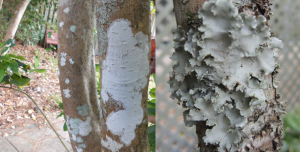
Lichens come in many forms and are commonly blamed for the decline and death of trees and shrubs, however they do not cause harm. Credit. Sydney Park Brown and Joseph Sewards, UF/IFAS.
A common misconception is that epiphytes, such as lichens and Spanish moss, are tree diseases. Epiphytes are known as “air plants” and thrive in the Panhandle. They survive on moisture and nutrients in the atmosphere and are harmless to trees. However, a tree that becomes inundated with epiphytes may be an indicator of excessive soil moisture, which may lead to root rot.
Lawn weed killers can have detrimental effects to trees, even if the application seems to be from a safe distance. When using a weed killer near a tree’s root system, confirm on the label that the product is designed to kill green growth only. It can’t be overstated that excessively fertilizing an old tree will greatly accelerate the decline of the tree. Some may think this will stimulate a tree and extend its life, but instead it will do the opposite. Young trees can tolerate fertilizer applications, as they need crown growth. Older trees will simply become top heavy, and structural damage will likely occur.
Don’t forget, trees need space too. A mature tree forced to occupy a small space will simply not adapt. Be sure to have adequate spacing when planting younger trees and shrubs in the vicinity of older trees. Also, keep your trees pruned away from touching structures and utilities.
Tree dieback is a complex issue to manage. By following these measures, you can help extend the life of your trees and continue to have a picturesque landscape.
For more information on tree dieback, contact your local county extension office.
Please visit Florida Friendly Landscaping, http://fyn.ifas.ufl.edu/, for more information on maintaining your landscape.
For more general information on lichens, please see UF/IFAS EDIS document “Spanish Moss, Ball Moss and Lichens-Harmless Epiphytes” by Joe Sewards and Dr. Sydney Park Brown: https://edis.ifas.ufl.edu/pdffiles/EP/EP48500.pdf
UF/IFAS Extension is an Equal Opportunity Institution.
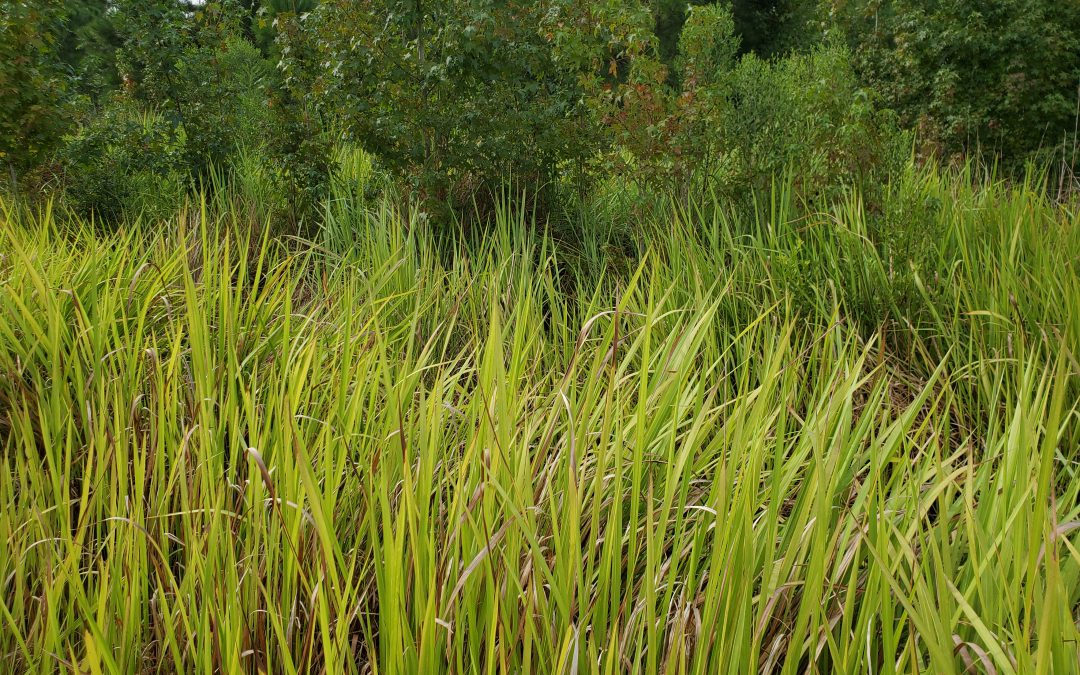
by Daniel J. Leonard | Oct 8, 2021
Over the last decade or so, the Panhandle has been overrun, and I don’t just mean by the summer beach traffic. Rather, by an aggressive, exotic perennial grass that quickly displaces all native species, is not useful as a forage to wildlife or livestock, can spread by roots or seeds, and has no natural enemies. If you own property in the Panhandle or spend any amount of time on its roads, chances are you have become acquainted with this worst of invasive species, Cogongrass (Imperata cylindrica).
A native of Southeast Asia, cogongrass was introduced into the US in 1912 around Mobile, AL as a hitchhiker in orange crate packing. Then the 1920s, 30s, and 40s, it was intentionally introduced from the Philippines into other Gulf Coast states, including Florida, as a potential pasture forage for livestock. Since then, cogongrass has become one of the most economically and ecologically important invasive species in the US and worldwide, infesting nearly 500 million acres and is now found on every continent.
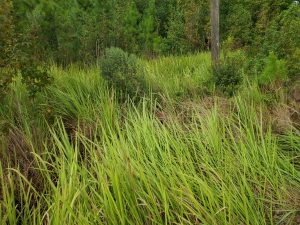
Cogongrass in Calhoun County, FL. Photo courtesy of Daniel Leonard.
Cogongrass is easily identified in late spring, when the grass throws easily spotted fluffy, white-colored seedheads above the mats of grass beneath. Additionally, patches of cogongrass are almost always noticeably circular in nature, radiating out indefinitely from the initial infestation. A closer inspection of the grass will reveal light green leaves up to 4’ in length, with an off-center, silvery colored midrib (the primary leaf vein that runs from the base of the leaf to the tip) and serrated leaf edges. Underground, cogongrass exhibits a dense underground root system that can reach as deep as 4’. This feature is the primary reason cogongrass outcompetes other plants, withstands any drought, fire, or soil condition thrown at it, aids in its resistance to herbicide activity, and generally makes it very difficult to manage.
The first step in managing cogongrass is prevention. If your property or the property you manage doesn’t have cogongrass, do everything you can to keep it that way. While the species can spread distances through seed dispersal, it is much more frequently moved around by fragmented rhizomes hitching a ride on equipment. If you or a contractor you’ve hired are working in or around an area with cogongrass present, avoid disturbing it with equipment and be diligent in monitoring the site for outbreaks following the job’s completion.
If you find cogongrass on your property, effectively eradicating it requires patience, persistence, and several years’ worth of herbicide applications. Currently, of the hundreds of herbicides available for purchase, only two chemistries have been proven to be very effective in destroying cogongrass, impazapyr (Arsenal, Stalker, etc.) and glyphosate (Roundup, Cornerstone, etc.).
- Imazapyr is an extremely effective non-selective, residual herbicide that controls a wide variety of weed species, including cogongrass. Just one or two applications of imazapyr can provide 18-24 months of effective cogongrass control, with follow up treatments required as needed after that. However, Imazapyr has a major downside that limits its use in many settings. Because it is a non-selective herbicide with significant soil residual activity, it cannot be used around the root zones of desirable plants. Oaks, other hardwood trees, and most landscape plants are especially sensitive to imazapyr. This herbicide is best limited to use in fields, waste/fallow areas, natural areas, and monoculture pine plantations – it is not appropriate in most residential and commercial landscapes.
- The other option, glyphosate is a non-selective herbicide with no soil residual activity. It is often a better option where severe injury or death of desirable hardwood trees and ornamental plants cannot be tolerated. However, due to its lack of residual soil activity, glyphosate applications on cogongrass patches will need to be repeated on an annual or biannual basis for up to five years for eradication of the infestation.
*Regardless of which herbicide you choose, controlling cogongrass is a multi-year affair requiring diligence and patience.
For more information on cogongrass and for specific herbicide recommendations and application rates/timing for your site, please contact your local UF/IFAS County Extension Office.
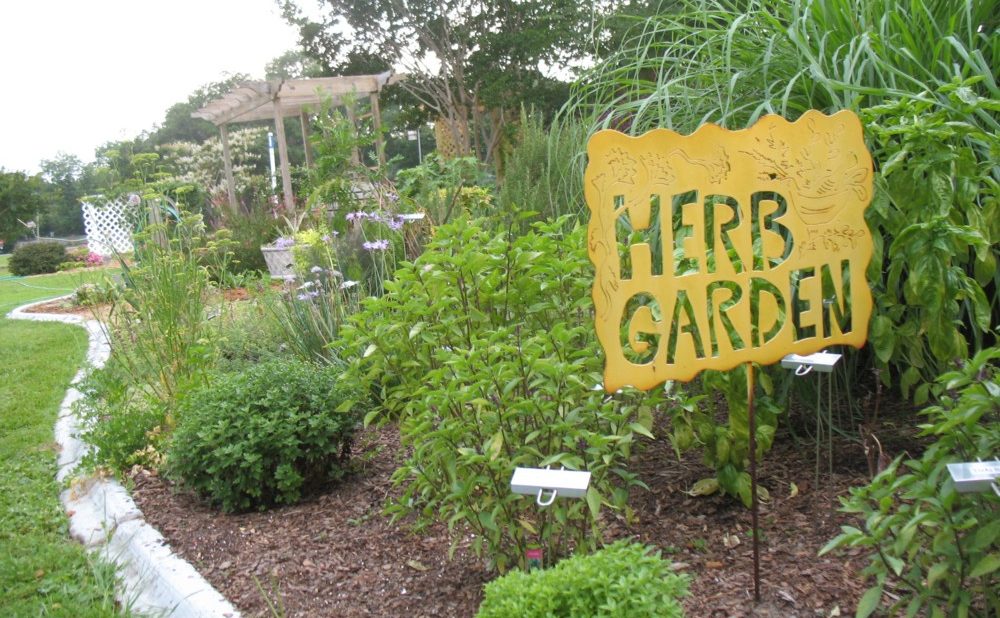
by Ashley Stonecipher | Sep 23, 2021
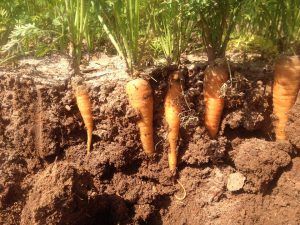
Photo by Full Earth Farm.
Yes, that’s right! We made it through the hottest part of the year and we are looking ahead to fall just around the corner! I am excited to be discussing September and what we can do to prepare for fall in the garden. As the nighttime temperatures start to cool down, we are given many more options.
For annual color plantings in September, try Ageratum, Celosia, Zinnias, and Wax Begonia to add fall color to your landscape. Bulbs will also add color, texture, and pattern to a bed. If you have some extra space, a variety of elephant ears could really accent a bed or you could always go with the classic calla, narcissus or zephyr lily. Popular vegetables to plant in North Florida in September are broccoli, carrot, cabbage, and collards. See Vegetable Gardening in Florida This is also the time of year to establish strawberry plants. Some great herbs to get started are Mexican tarragon, mint, rosemary, and basil.
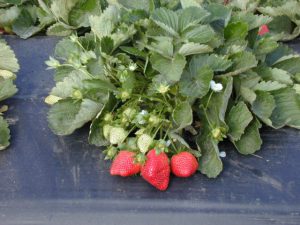
Image Credit: Matthew Orwat UF/IFAS Extension Washington County
There are many things that can be done in your lawn during September. Monitoring your lawn for its health and potential insect pests is important this time of year. Common insects to scout for are fall armyworms, chinch bugs, mole crickets, and sod webworms. The last fertilizer application should be done by the middle to end of September. Make sure you choose a fertilizer with little to no phosphorus unless a soil test shows differently. To maintain a healthy lawn, avoid weed and feed products and only apply herbicides in areas with high infestations of weeds. Weed and feed products are not recommended because the timing of when to fertilize and the timing of the weed killer is not always the same. The best management practice is to use a separate treatment for weeds and when possible spot treat weeds.
If you already have bulbs in your landscape from previous growing seasons, this is the time to divide and replant those that are big. You can also add organic matter to new planting areas. Continue working on your vegetable plants and prepare them for either transplants for a fast start, or plants seeds for more variety. Throughout your landscape, it is important that plants are getting the right amount of water as we go in and out of wet and dry weather this time of year.
October will be here before we know it in just a couple of weeks. Look out for the next article to come. We will be getting into the cooler nights and more options for planting vegetables and herbs!
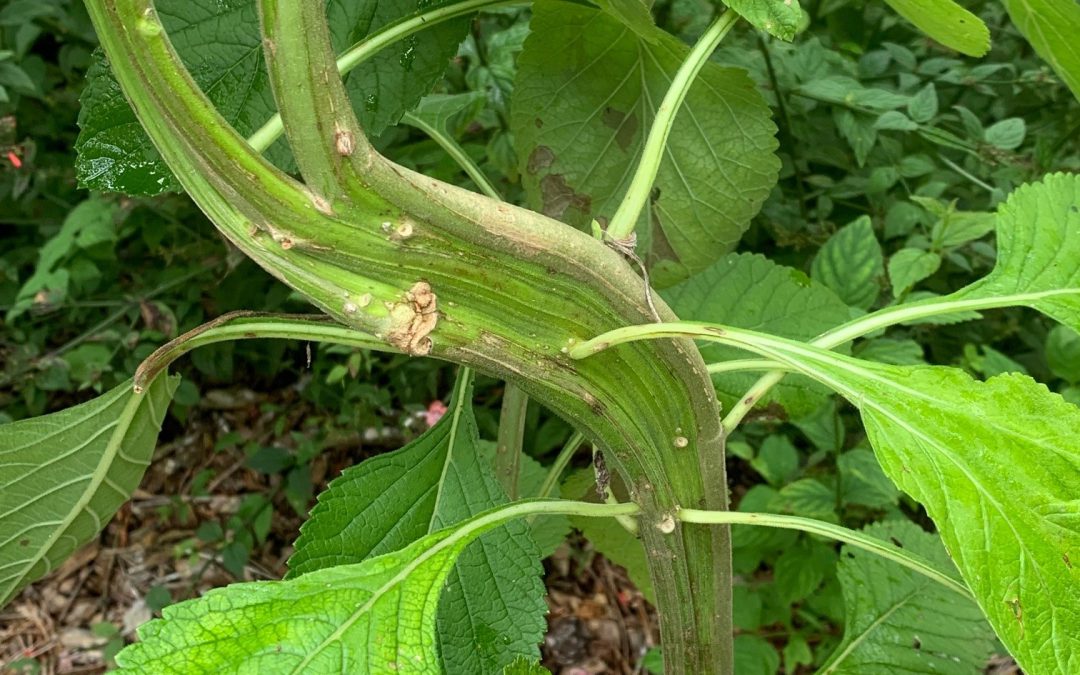
by Beth Bolles | Sep 16, 2021
Every so often while I am enjoying a walk through the garden, I notice a growth pattern on a plant that is just not normal. One of the more interesting patterns I see is called fasciation. This is a distortion of plant tissue that often causes flattened, curved, or the thinning of plant tissues. I recently noticed this on the stem of a Coral Porterweed in the Escambia County Demonstration Garden. The leaves were a normal shape but several inches of the stem were flattened and curved.
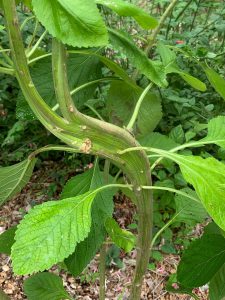
The distorted stem tissue of a Coral porterweed. Photo by Beth Bolles, UF IFAS Extension Escambia County.
So what is causing this type of growth pattern?
The most common cause of fasciation is usually some type of genetic mutation in the growing points of the plant. The other possible causes could be a physical injury to new tissues, a bacterial infection, chemical injury, or even an insect injury. Fasciation will be random in its occurrence and many gardeners may never have it occur on a plant in their yard. I have seen it on both woody and herbaceous plants in my own yard and in the demonstration gardens.
If you see a plant exhibiting this distortion of growth, you don’t need to take any action. If the growth is unsightly to you, prune out the affected plant tissue. It is probably best that you not propagate material from an affected plant just to prevent any transfer of the distortion to a new plant if the cause is genetic or from a living organism.
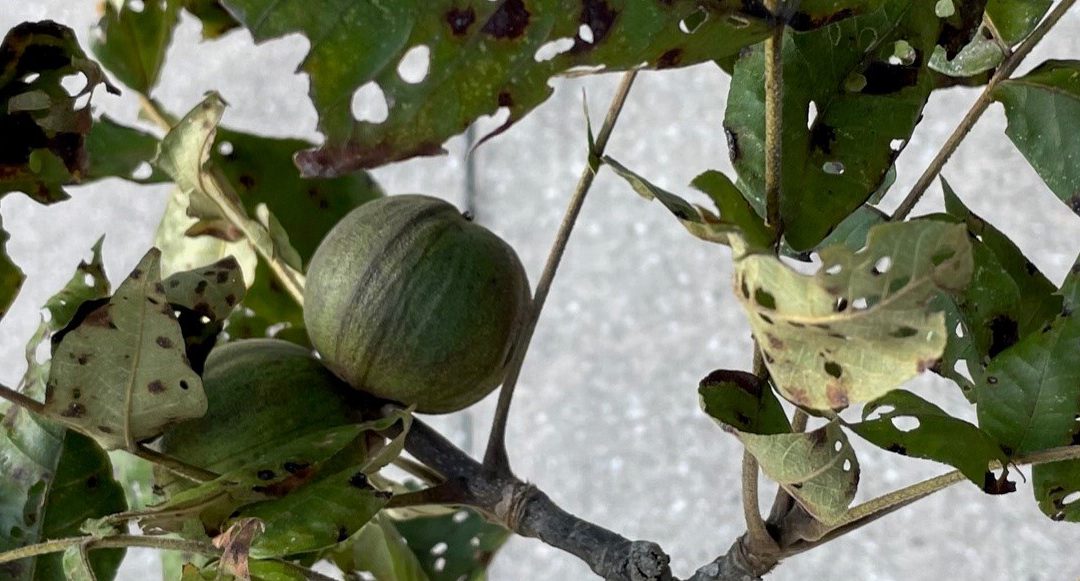
by Pat Williams | Sep 9, 2021
As homeowners, we do value our trees and no one wants to lose a shade tree especially on the house’s south side in Florida. On a recent site visit, a hickory tree had multiple concerns. Upon closer inspection, the tree had a bacterial infection about 30” off the ground with a smelly, black-brown ooze seeping forth. The leaf canopy was riddled with beetle holes and leaf margins were chewed by caterpillars. When leaves were viewed under the microscope, thrips (insects) and spider mites were found running around. The biggest homeowner cosmetic concern arose from hickory anthracnose (fungus) and upon closer inspection found the leaves to have hickory midge fly galls. The obvious question is should the tree come down? I’ll have you read the whole article before giving you the answer.
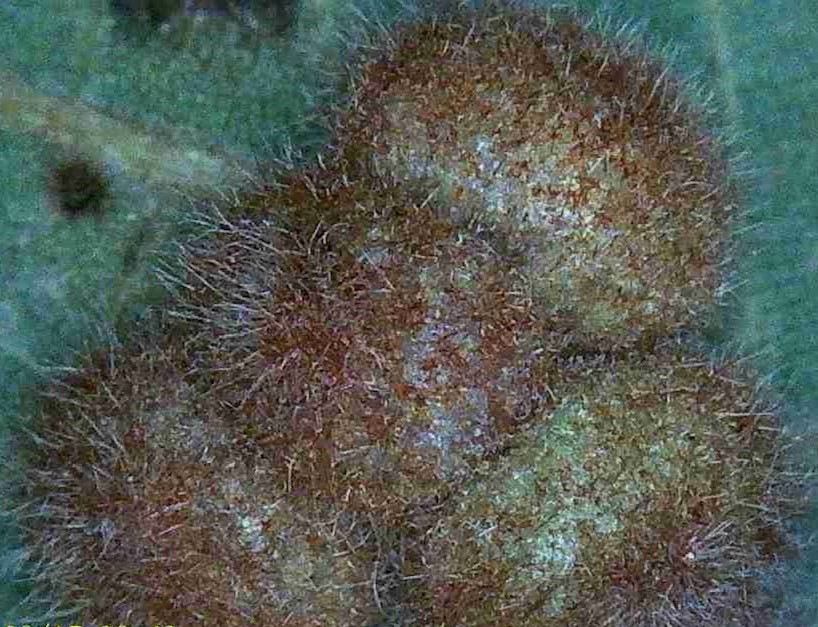
Each hickory gall is approximately 3/16″ wide.
Hickory anthracnose or leaf spot as seen in the banner photo is caused by a fungal infection during the wet summer months in Florida. The homeowner can usually recognize the disease by the large reddish brown spots on the upper leaf surface (sending a sample to the NFREC Plant Pathology Lab will confirm the diagnosis) and brownish spots with no formal shape on the bottom. Be sure to rake and remove all leaves to prevent your disease from overwintering close to the tree thus reducing infection next year.
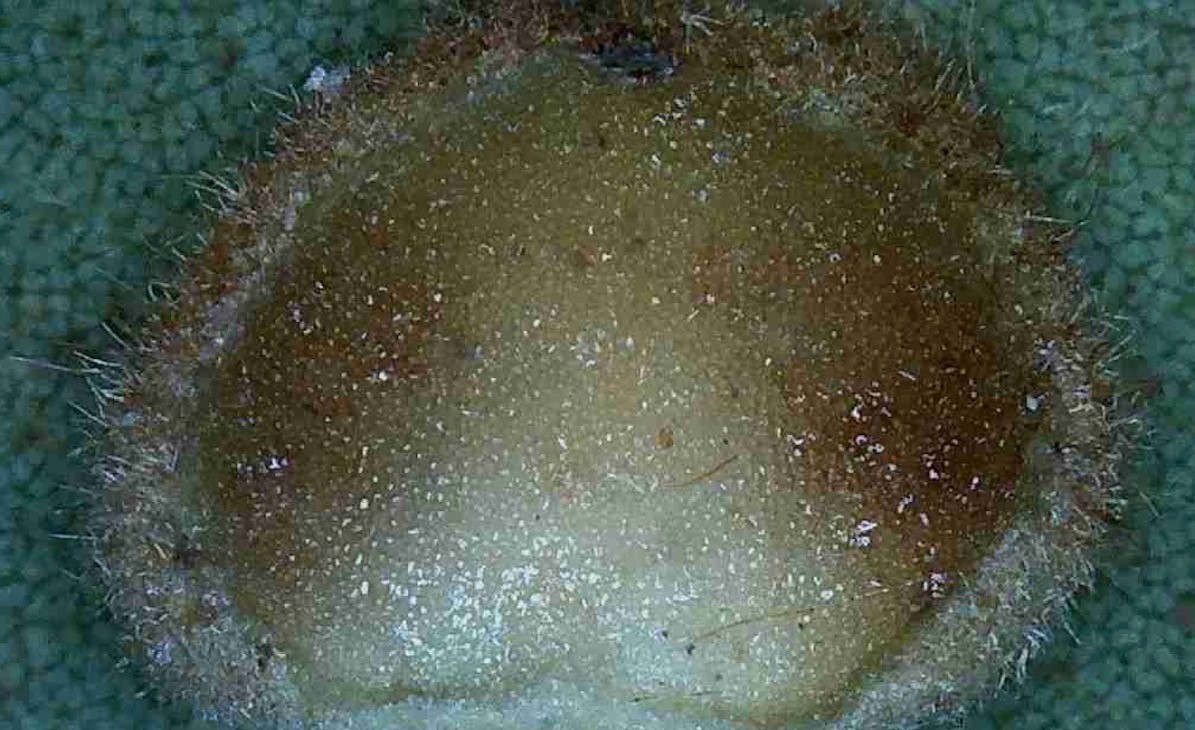
A hickory gall has been cut in half to show the leaf tissue.
The fungus can be lessened by good cultural practices and appropriate fungicidal applications. Please remember it is best left to professionals when spraying a large tree. This alone is not cause to remove your tree.
Hickory gall is caused by the hickory midge fly, an insect that lays eggs in the leaf tissue. The plant responds by building up tissue around each egg almost like the oyster when forming a pearl.
As the gall tissue grows, eggs hatch and larva start to feed on this tissue. The larva will continue to
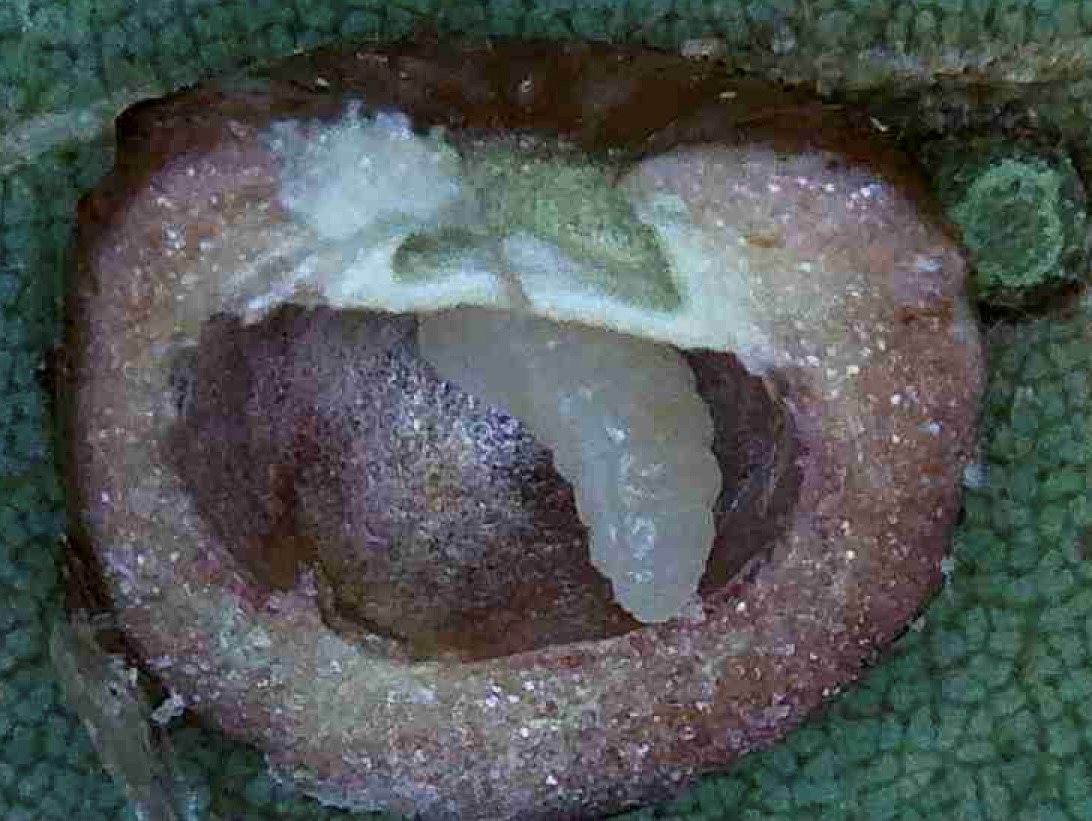
The larva has eaten all soft material inside the gall and is ready to pupate.
feed until it is ready to pupate within the gall. After forming a pupa, the midge fly will eventually emerge as an adult and females will continue to lay eggs on other leaves. The galls are more of a cosmetic damage and because your hickory leaves will fall from the tree as winter comes, the galls will normally not cause enough damage to worry about each year. Once again good cultural practices and disposal of each year’s leaves will reduce the gall numbers next year.
In a large tree with many leaves, foliar feeding by beetles and caterpillars do cause damage though the leaves will still produce enough food (photosynthesis) to keep the tree alive. Most of us never climb our trees to look at leaves to see the small insects/mites and there are more than enough leaves to maintain tree health.
The biggest concern during my site visit was their tree’s bacterial infection. A knife blade was pushed into the wound area and went in less than 1/4″. The homeowner was instructed to look at bactericide applications. In the end, this hickory tree with so many problems is still shading the home and helping cool the house. It is still giving refuge to wildlife and beneficial insects. When in doubt give our trees the benefit and keep them in place. Remember your local Extension agent is set up to make site visits and saving a tree is time well spent.
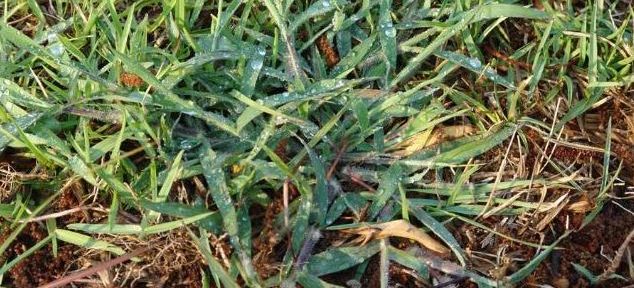
by Larry Williams | Aug 26, 2021
Hot, summer months are not the time to be using most lawn herbicides.
One issue is the heat of summer. Most lawn herbicide labels include statements such as the following.
“Do not apply when temperature exceeds 90°F.” “Do not broadcast apply this product when air temperatures are above 90°F (85°F for St. Augustinegrass) unless temporary turf injury can be tolerated.”
Every year we’ll see lawns that are injured or killed because of lawn herbicides being applied when temperatures are too hot.
Summer is usually a rainy and windy time of the year. Many lawn herbicide labels include statements such as the following.
“Allow 12 hours after application before watering lawn for maximum effectives on listed weeds.” “Apply only when wind is no more than 10 mph.” “Applying this product in calm weather when rain is not predicted for the next 24 hours will help to ensure that wind or rain does not blow or wash pesticide off the treatment area.”
It is critical to read and follow the label directions and precautions for any pesticide you use. Pesticide labels, including herbicides, include the following statements.
“To the extent consistent with applicable law, the buyer assumes all risks of use, storage, or handling of this product not in accordance with label directions.” “It is a violation of Federal law to use this product in a manner inconsistent with its labeling.”
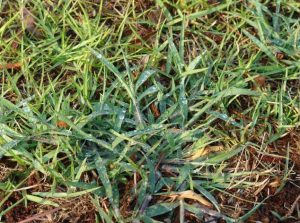
Crabgrass growing in centipedegrass lawn. Photo credit: UF/IFAS Extension
By the time summer arrives, many of the lawn weeds are mature, which means they are well established with extensive root systems. These mature, well established weeds are much more difficult to control. They are more susceptible to herbicides when they are small, young, and not well established. Also, these mature weeds have been allowed to produce countless numbers of seeds as they move into summer. Most weeds are prolific seed producers. For example, a single crabgrass plant (a common summer lawn weed) can produce 150,000 seeds.
Applying a preemergence lawn herbicide in February to help prevent summer annual weeds such as crabgrass or applying a postemergence lawn herbicide during spring while the weather is mild and before the weeds are out of control simply makes more sense than waiting until summer.
The best options now with lawn weed control involve continuing to follow good mowing practices, maybe hand removal of some weeds, and just simply waiting it out until next February and spring to worry with the use of lawn herbicides.
In the meantime, you may want to read the following UF/IFAS Extension publication on lawn weed control.
https://edis.ifas.ufl.edu/pdf/EP/EP14100.pdf
Larry Williams, UF/IFAS















